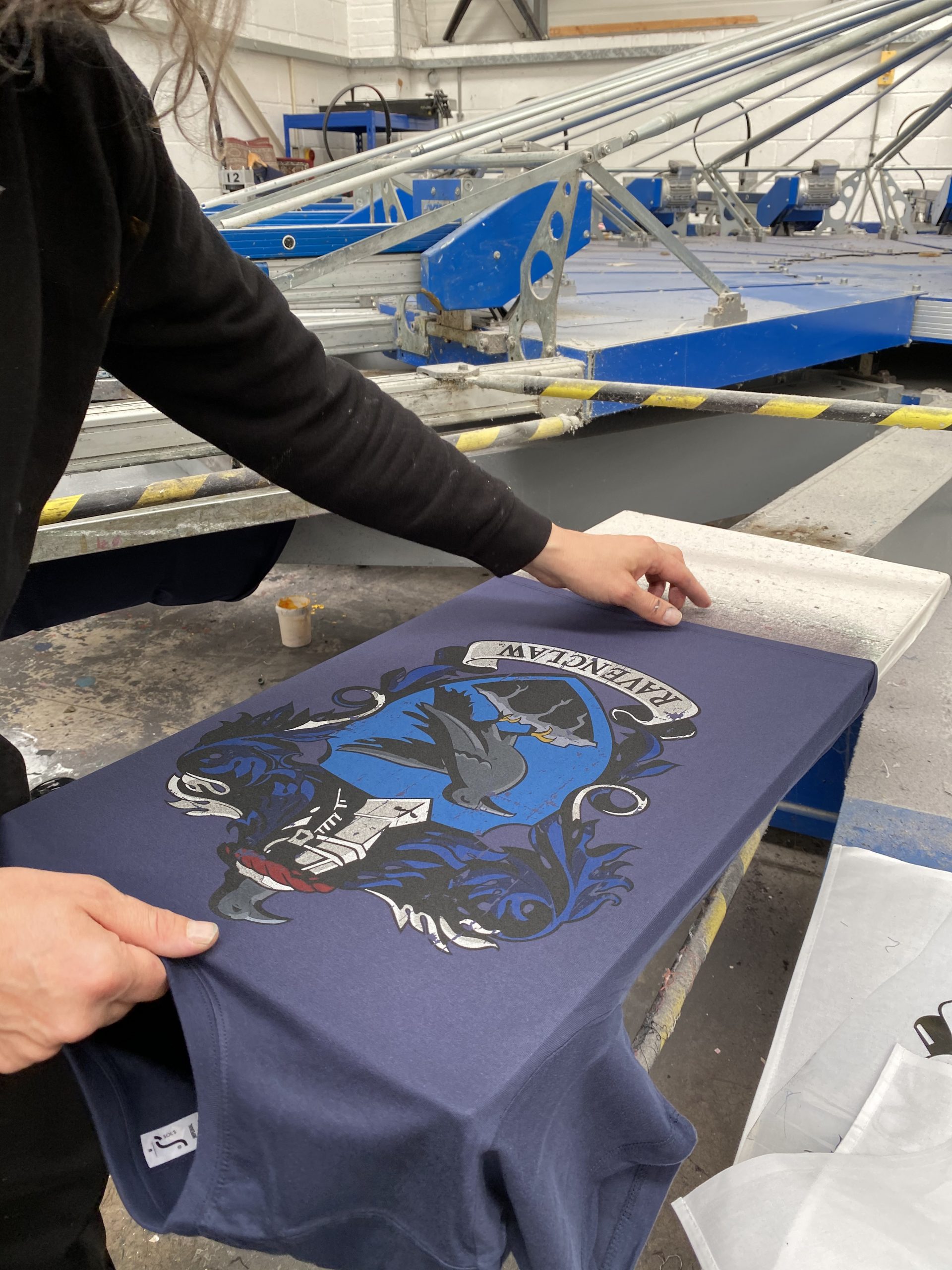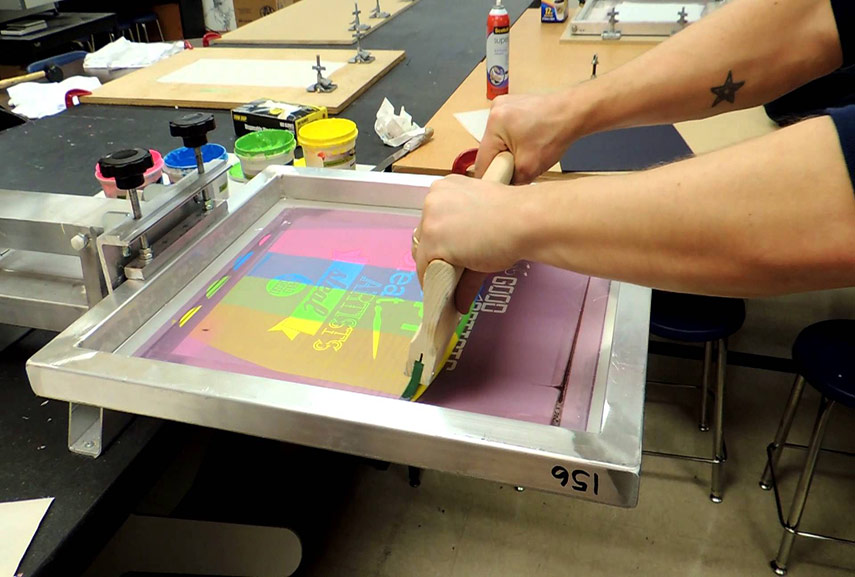The Vital Guide to Understanding Screen Printing and Its Versatile Uses
Screen printing has a rich background that goes back to ancient times, advancing right into a sophisticated method made use of throughout numerous sectors today. This overview explores the ins and outs of the screen printing procedure, detailing its applications in fashion, home, and marketing decoration - 10:9 Design near me. Comprehending these fundamentals can open innovative potential for both artistic and business projects. The following areas will reveal necessary pointers and methods to boost one's screen printing undertakings
The Background of Screen Printing
Although screen printing has origins that trace back centuries, its development reflects the imaginative and technological advancements of various societies. Coming from old China, the method was originally made use of for embellishing textiles and later spread to Japan, where it came to be important to Ukiyo-e woodblock printing. The method moved to Europe in the 18th century, where it obtained popularity among craftsmens and commercial printers. The innovation of image emulsion in the 20th century changed screen printing, permitting even more intricate layouts and higher effectiveness. Musicians like Andy Warhol even more moved its popularity, using the tool to create legendary jobs that blended commercialism and art. By the late 20th century, screen printing had developed itself as a flexible technique, employed in fashion, advertising and marketing, and great art. Today, it remains to advance, incorporating digital technology and broadening its applications across various markets.
The Screen Printing Refine Explained
Screen printing transforms imaginative visions into tangible layouts via a series of precise steps. A picture is developed and then transferred onto a screen, generally made of fine mesh fabric extended over a frame. A light-sensitive emulsion is used to the screen, which is subjected to light, solidifying in locations not covered by the picture. After washing out the unhardened emulsion, a stencil is developed.
Next, the screen is put over the substratum, whether it be fabric, paper, or one more product. Ink is then pushed with the open areas of the stencil utilizing a squeegee, depositing the design onto the substratum listed below. This procedure can be repeated for numerous colors, calling for separate screens for each hue. The published thing is cured making use of warmth to assure the ink sticks properly, resulting in a resilient, dynamic design ready for usage.
Kinds Of Screen Printing Techniques

Furthermore, specialty techniques, such as discharge screen printing, get rid of dye from the material to develop softer prints, while aluminum foil screen printing uses metal aluminum foil to attain a glossy coating (10:9 Design Screen Printing). Each technique provides distinct characteristics, satisfying various imaginative demands and production scales, ultimately expanding the opportunities within the screen printing domain
Applications of Screen Printing in Various Industries

Furthermore, the signage and marketing markets make use of screen printing for developing eye-catching displays and banners. This technique permits bold shades and detailed layouts that capture interest. In electronics, screen printing is utilized for applying conductive inks to circuit boards, important for component connections. The home design market welcomes screen printing to generate distinctive styles on textiles and wall surface art. In general, screen printing offers as an important tool throughout diverse fields, enhancing items with customized and visually attractive graphics.
Tips for Successful Screen Printing Projects
While embarking on a screen printing project, careful interest to information can significantly boost the last end result. Initially, choosing top notch materials is necessary; this includes the screen, inks, and substrates. Using ideal mesh counts can impact ink deposition and detail resolution. Prep work is just as crucial; detailed cleaning of displays and correct exposure times ensure crisp prints.
Next Recommended Site off, exact registration is essential for multi-color prints. Using placement devices can assist attain smoking area signs to print exact layering. Furthermore, screening prints on scrap materials before production helps recognize prospective issues without losing sources.

Frequently Asked Questions
What Materials Are Ideal for Screen Printing on Textile?
Cotton and polyester blends are suitable for screen printing on fabric due to their durability and ink absorption. In addition, specialty fabrics like silk or canvas can create distinct appearances and surfaces, boosting the total design high quality.
Just how Do I Tidy and Maintain Screen Printing Equipment?
To cleanse and keep screen printing equipment, one should frequently clean screens with appropriate solvents, evaluate squeegees for wear, lube relocating components, and store all things in a completely dry, dust-free environment to lengthen their life expectancy.
What Are the Ecological Influences of Screen Printing?
Screen printing can have considerable ecological influences, consisting of chemical waste from inks and solvents, water use throughout cleansing processes, and power intake. Environment-friendly products and lasting techniques are crucial for minimizing these unfavorable results.
Can Screen Printing Be Done at Home Efficiently?
Screen printing can be properly done at home with the right materials and techniques. Enthusiasts can create top quality prints, though success depends upon their ability level, devices, and understanding of the procedure entailed.
What Are the Prices Related To Beginning a Screen Printing Organization?

Beginning a screen printing business entails prices for tools, products, and work area. Initial expenditures generally range from a couple of hundred to several thousand dollars, relying on the scale, top quality of equipment, and preferred production ability.
Screen printing has an abundant background that dates back to ancient times, progressing into a sophisticated method utilized across numerous sectors today. One more technique, rotary screen printing, employs cylindrical screens, promoting continual printing on fabric rolls, thus improving effectiveness for massive manufacturings. In addition, specialty techniques, such as discharge screen printing, remove dye from the material to create softer prints, have a peek at these guys while foil screen printing uses metal foil to attain a shiny finish. In the style sector, screen printing is widely made use of to create vibrant layouts on clothing, making it possible for brands to showcase their unique designs. Cotton and polyester blends are suitable for screen printing on fabric due to their longevity and ink absorption.